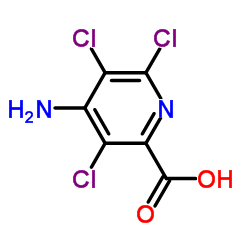Picloram

Picloram structure
|
Common Name | Picloram | ||
|---|---|---|---|---|
| CAS Number | 1918-02-1 | Molecular Weight | 241.459 | |
| Density | 1.8±0.1 g/cm3 | Boiling Point | 420.5±45.0 °C at 760 mmHg | |
| Molecular Formula | C6H3Cl3N2O2 | Melting Point | 200 °C (dec.)(lit.) | |
| MSDS | Chinese USA | Flash Point | 208.1±28.7 °C | |
| Symbol |

GHS07 |
Signal Word | Warning | |
|
Quantitative structure-activity relationship and complex network approach to monoamine oxidase A and B inhibitors.
J. Med. Chem. 51 , 6740-51, (2008) The work provides a new model for the prediction of the MAO-A and -B inhibitor activity by the use of combined complex networks and QSAR methodologies. On the basis of the obtained model, we prepared and assayed 33 coumarin derivatives, and the theoretical pr... |
|
|
Characterization of tub4(P287L) , a β-tubulin mutant, revealed new aspects of microtubule regulation in shade.
J. Integr. Plant Biol. 57 , 757-69, (2015) When sun plants, such as Arabidopsis thaliana, are under canopy shade, elongation of stems/petioles will be induced as one of the most prominent responses. Plant hormones mediate the elongation growth. However, how environmental and hormonal signals are trans... |
|
|
GH3 expression and IAA-amide synthetase activity in pea (Pisum sativum L.) seedlings are regulated by light, plant hormones and auxinic herbicides.
J. Plant Physiol. 170(4) , 361-8, (2013) The formation of auxin conjugates is one of the important regulatory mechanisms for modulating IAA action. Several auxin-responsive GH3 genes encode IAA-amide synthetases that are involved in the maintenance of hormonal homeostasis by conjugating excess IAA t... |
|
|
Residue dynamics of clopyralid and picloram in rape plant rapeseed and field soil.
Bull. Environ. Contam. Toxicol. 86(1) , 78-82, (2011) A new method for simultaneous analysis of clopyralid and picloram residues in rape plant, rapeseed and field soil was developed and validated. The residual dynamics and final residues of clopyralid and picloram in rape plant, rapeseed and soil were determined... |
|
|
Simultaneous determination of aminopyralid, clopyralid, and picloram residues in vegetables and fruits using ultra-performance liquid chromatography/tandem mass spectrometry.
J. AOAC Int. 95(2) , 554-9, (2012) A sensitive and effective method for the simultaneous quantitative determination of aminopyralid, clopyralid, and picloram in vegetables (eggplant, cucumber, and tomato) and fruits (apple and grape) was developed and validated using ultra-performance LC coupl... |
|
|
Determination of chlorinated acid herbicides in vegetation and soil by liquid chromatography/electrospray-tandem mass spectrometry.
J. AOAC Int. 90(5) , 1402-10, (2007) The method presented uses reversed-phase liquid chromatography with negative electrospray ionization and tandem mass spectrometry to analyze 9 chlorinated acid herbicides in soil and vegetation matrixes: clopyralid, dicamba, MCPP, MCPA, 2,4-DP, 2,4-D, triclop... |
|
|
Using accelerated life testing procedures to compare the relative sensitivity of rainbow trout and the federally listed threatened bull trout to three commonly used rangeland herbicides (picloram, 2,4-D, and clopyralid).
Environ. Toxicol. Chem. 27(3) , 623-30, (2008) We conducted 96-h static acute toxicity studies to evaluate the relative sensitivity of juveniles of the threatened bull trout (Salvelinus confluentus) and the standard cold-water surrogate rainbow trout (Onchorhyncus mykiss) to three rangeland herbicides com... |
|
|
A temporary immersion system improves in vitro regeneration of peach palm through secondary somatic embryogenesis.
Ann. Bot. 108(8) , 1463-75, (2011) Secondary somatic embryogenesis has been postulated to occur during induction of peach palm somatic embryogenesis. In the present study this morphogenetic pathway is described and a protocol for the establishment of cycling cultures using a temporary immersio... |
|
|
Carcinogenicity of picloram.
J. Toxicol. Environ. Health A 7(2) , 207-22, (1981) Two studies of the carcinogenicity of the herbicide picloram in animals were reviewed. Examination of histological sections showed that picloram is highly carcinogenic in rats and mice. Neoplasms at all sites, including malignant neoplasms, were increased in ... |
|
|
Toxicity of neurons treated with herbicides and neuroprotection by mitochondria-targeted antioxidant SS31.
Int. J. Environ. Res. Public Health 8(1) , 203-21, (2011) The purpose of this study was to determine the neurotoxicity of two commonly used herbicides: picloram and triclopyr and the neuroprotective effects of the mitochondria-targeted antioxidant, SS31. Using mouse neuroblastoma (N2a) cells and primary neurons from... |